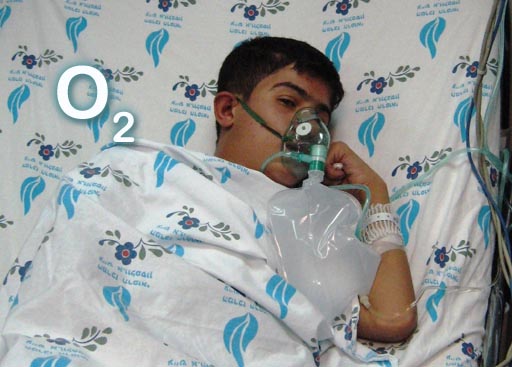
Oxygen in the air is diatomic (two atoms connected), but chemists don't call it dioxygen, the correct name is oxygen. In the medical field they usually call it "O-two", "medical oxygen", or simply oxygen. Likewise, other gases like fluorine (F2) and chlorine (Cl2) are simply called fluorine and chlorine; it's understood that they travel in pairs.
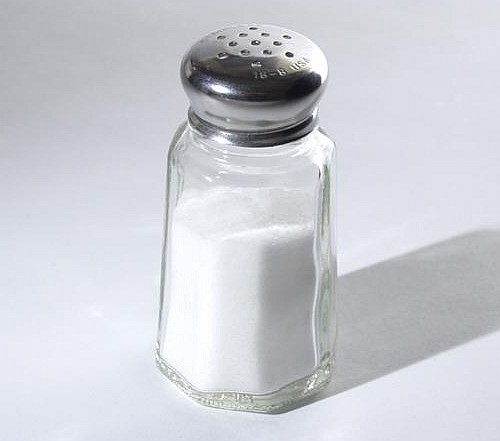
Sodium chloride is a typical binary ionic compound. "Binary" means there are two elements bonded together. "Ionic" means each are ions (Na+ and Cl-). Since opposite charges attract, this causes them to bond (combine) to make a compound. When talking to patients with high blood pressure, medical staff will say, "Reduce your intake of salt." This use of "salt" means sodium chloride (NaCl).
Salt is a general term for any metal combined with any non-metal. However, in everyday language, this word usually means sodium chloride.
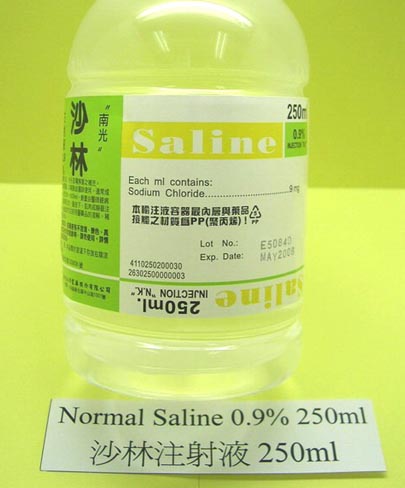
Saline is a term the medical profession uses for a sodium chloride solution. "Normal Saline" means a sodium chloride solution that is 0.9% w/v [weight/volume]. 0.9% w/v means 0.9 grams per 100 mL of solution. You can make it by putting 9 grams of sodium chloride in water and then bring up the volume to 1 liter.
"Normal" means that the salt level is close to the "salt" or "ion" levels in blood. That's why normal saline is given to dehydrated patients who can't take liquids orally. It is administered by IV (intravenous) through injection or use of a IV bag.
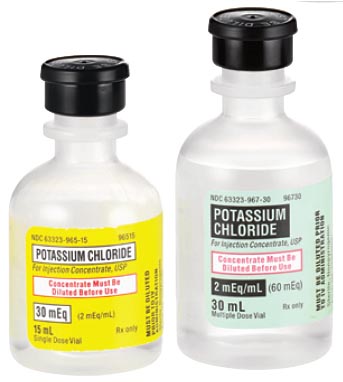
Potassium is needed for the proper functioning of muscles and nerves. If the body doesn't have enough potassium, the condition is called "hypokalemia". "Hypo" means under. "Kal" is from "Kalium" the Latin name for potassium (hence K as symbol). "emia" means blood. So hypokalemia means low levels of potassium in the blood. Potassium chloride is another binary ionic compound. Notice binary compounds end with "ide". The positive ion (potassium, K+) is always written first.

Titanium (IV) oxide is another binary ionic compound. It's used as a sunblock for people sensitive to the sun's UV light or are in high risk environments (mountains, snow, water)
Notice unlike sodium or potassium chloride, this name uses a Roman numeral between metal and non-metal. Sodium and potassium ions are always a plus one charge, so there's no need to indicate charge. Titanium however, can have a plus 2, plus 3, or a plus 4 charge, so there needs to be a way to indicate which one. The Roman numeral IV means this titanium has a plus 4 charge. To balance that charge, you would need two oxygen ions (oxide ions) because each oxygen ion is a negative 2 charge. So the formula is TiO2. This product names this compound as titanium dioxide, which is logical since there are two oxygen atoms; however, the organization that has the task to standardize chemical names says using the Roman Numerals will reduce misunderstandings. So the proper name is titanium (IV) oxide, but you are apt to see and hear it as titanium dioxide.
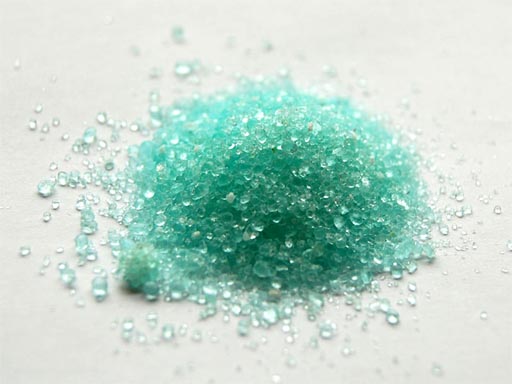
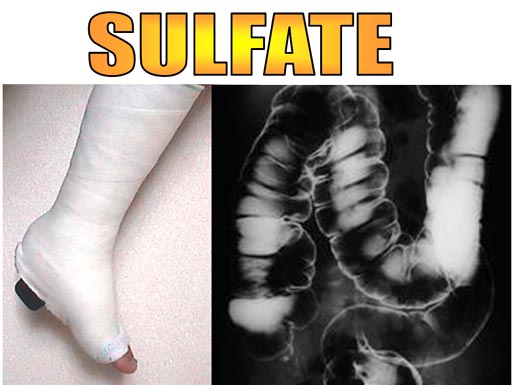
In the medical profession calcium sulfate and barium sulfate are often encountered.
Casts are made from calcium sulfate hemihydrate. (CaSO4 * 0.5H2O). "Hemi" means one half and "hydrate" means water. In other words, one water sits between two CaSO4 molecules.
Barium sulfate is taken orally (like a milkshake made from chalk)
and is used to absorb xrays. This allows the outline of the digestive
tract to be visible in xrays.
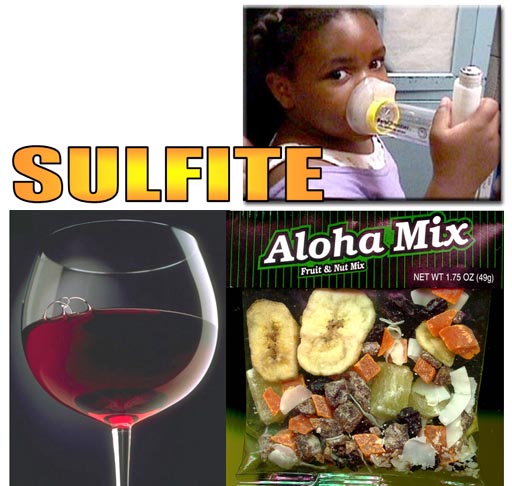
Sulfite: Sulfate has four oxygen atoms. If there are only 3 oxygen atoms, then the name changes to "sulfite". The formula is "SO32-". It still has a negative (minus) 2 charge. This ion is important in health care because 1 out 100 people are sensitive to sulfite causing sometimes severe allergic reactions. Some people have died. The normal allergic reaction is breathing difficulties. Sulfite is used as a preservative in wines and many foods (like trail mix).
Sulfites are used to sterilize fermentation equipment and food containers because of its antimicrobial properties. Generally meat, cereals and dairy products are not treated with it as it destroys the thiamine (vitamin B1) content.
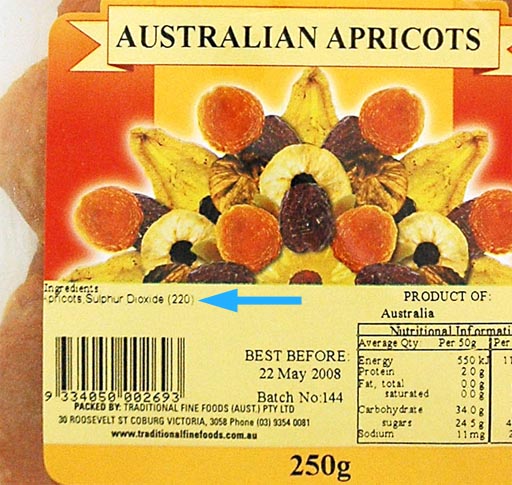
Most products don't list sulfite as an ingredient. They
will call it sulfur dioxide (or British spelling sulphur dioxide). Sulfur
dioxide is a gas. If you opened the bag, the sulfur dioxide would escape
and no longer be a preservative. However, there's some moisture in trail
mix or even "dried" fruit. Plus, there's water in wine. So the
sulfur dioxide they list has actually reacted with water. Here's the reaction:
SO2 + H2O -> H2SO3
The product is called sulfurous acid. Now you see why they don't want
to label it as sulfurous acid, which is very close to sounding like sulfuric
acid.
In water, the sulfurous acid breaks up into ions with one being sulfite:
H2SO3 -> 2H+ + SO32-
Now you can see the sulfite ion that some people are allergic to.
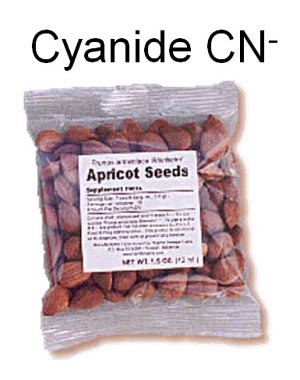
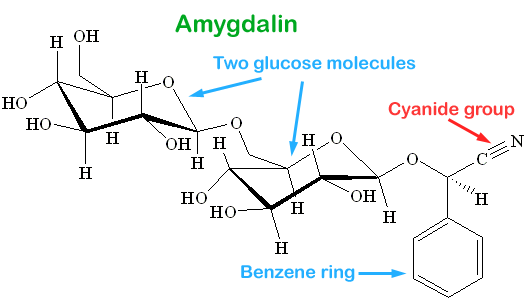
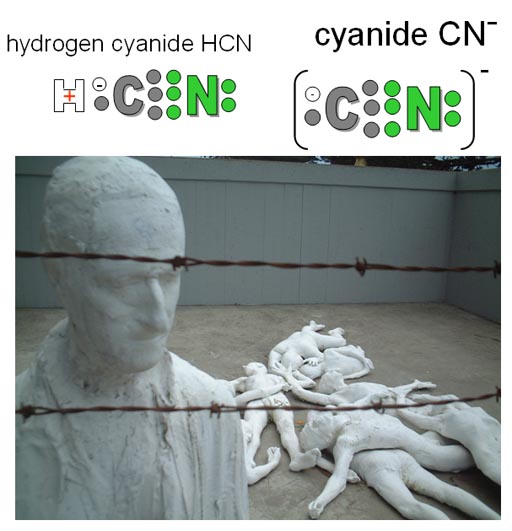
The type of cyanide used in gas chambers was hydrogen cyanide. It is a gas. As it got into the lungs and contacted water, it would break up into hydrogen ions and cyanide ions.
The other poisonous forms of cyanide are the sodium and potassium salts of cyanide. NaCN and KCN. These were used in suicide pills that spies carried with them.
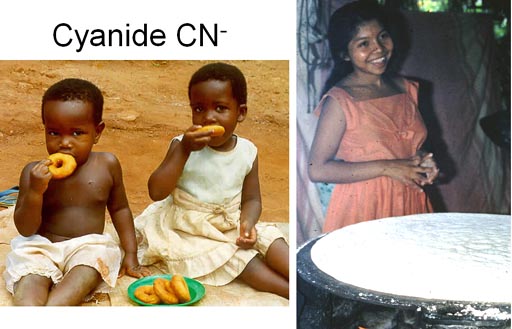

ACETATE:
Vinegar has been used for centuries to combat microbes in foods. That's
the basis of pickled foods. Vinegar in stores is a 5%
w/v (5 g/100mL) solution of acetic acid. In water some of the acetic acid
loses a hydrogen ion (acid) that gets grabbed by water.
HC2H3O2+
H2O -> C2H3O2-
+ H3O+
The negative ion of acetic acid is called "acetate". The water that has grabbed the H+ ion is called the hydronium ion.
Also in the picture is a bottle of zinc acetate, which is a cold remedy. The bag contains sodium acetate. See next row for more information.
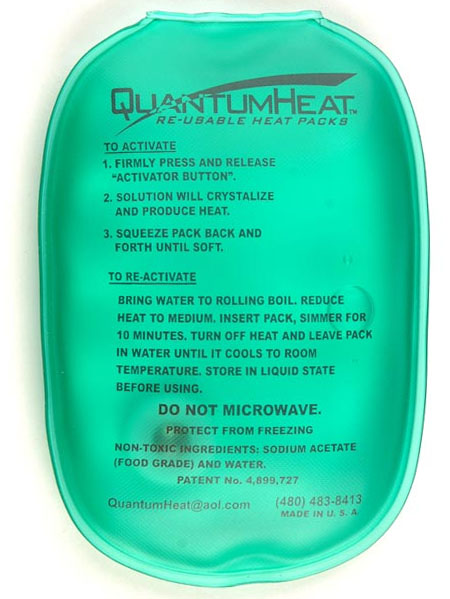
NaC2H3O2
Sodium acetate is used in instant heat packs. The way it works is very interesting chemistry. When placed in very hot water you can get a lot of sodium acetate to dissolve, but when it cools back down, some of the sodium acetate should precipitated out of the water, but it doesn't. They call that supersaturated because it has more sodium acetate dissolved that that cool temperature is capable of.
A single crystal of sodium acetate or a disturbance from the "activator button" can cause the sodium acetate in the solution to turn to a solid. At that point heat is released. The reason is that molecules in a liquid are moving around, but molecules in a solid are not moving around. Motion is energy, more specifically kinetic energy. When these molecules come to an abrupt halt as they go from liquid to solid, that kinetic energy has to go somewhere. That's the heat that is given off.
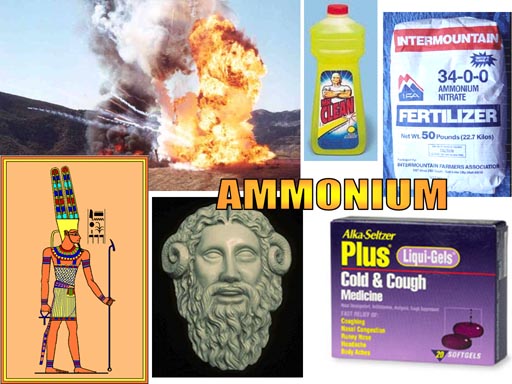
Nearly all polyatomic ions you encounter are negatively charged. Ammonium is one that is positively charge. Ammonium gets its name from the Egyptian Ram God, Ammon. A salt with special properties was discovered near the Temple of Ammon. It was called Sal (salt) Ammoniac (NH4Cl). When heated, it decomposes into ammonia and hydrogen chloride gases. NH4Cl -> NH3 + HCl.
Other images: Ammonium chloride is used in cough medicine. Ammonium nitrate is used as a fertilizer and as an explosive. Ammonium hydroxide (NH4OH) is used in cleaners.
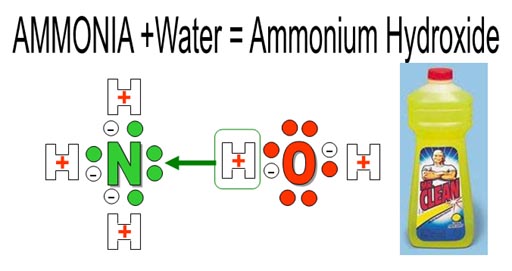

Ammonia is created in the body from digestion of proteins and amino acids (middle image: notice the amino part of this amino acid). If there’s an excess of nitrogen, the body converts it to urea, which is less toxic than ammonia. Urea is expelled in the urine.
Some babies are born without the enzymes to convert
ammonia to urea, so they develop hyperammonemia, which is fatal or
will cause brain damage if not treated. A case story about this disease
is here: http://www.glennon.org/archives/
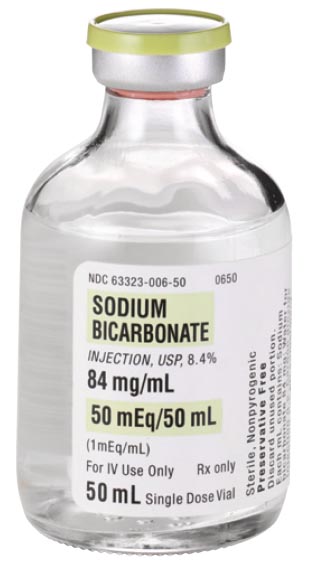
Bicarbonate (HCO3-):
In chemistry the new preferred name is hydrogen carbonate; however, you will probably see the name, bicarbonate, persist in the medical field for a long time.
Sodium bicarbonate (NaHCO3) is used in emergency situations like heart attacks, kidney failures, and lung problems to correct a pH imbalance from too much acid in the blood. Here's the chemical equation of neutralizing acid (H+):
H+ + HCO3- -> H2CO3
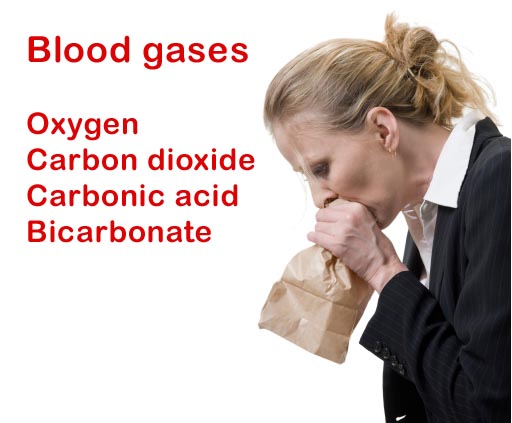
CO2 + H2O -> H2CO3 -> H+ + HCO3-
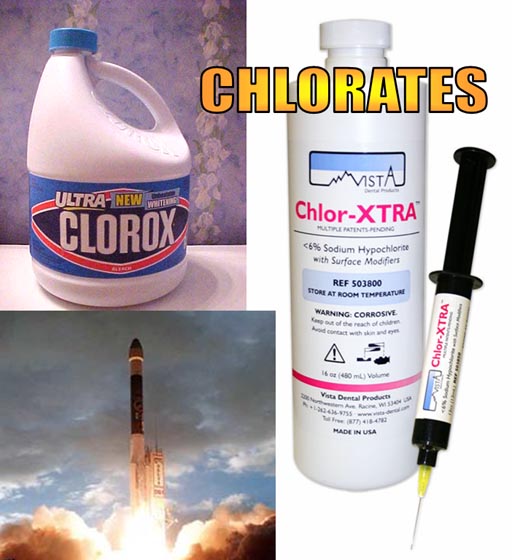
Chlorates: Chlorates are a group of polyatomic ions that are have one chlorine atom and one to four oxygen atoms. (ClO-, ClO2-, ClO3-, & ClO4-). The names in same order are hypochlorite, chlorite, chlorate, and perchlorate.
In the medical field, sterilization is always critical. One chlorate, sodium hypochlorite (NaClO), is the main ingredient in Clorox and is commonly used as an disinfectant. A syringe with NaClO solution is used in dentistry to clean and disinfect root canals.
Chlorate, and perchlorate are also used as a source of oxygen in fireworks and in rocket fuel. Perchlorates from dumped rocket fuel have contaminated the water supply in several states. This is a health issue currently being examined.
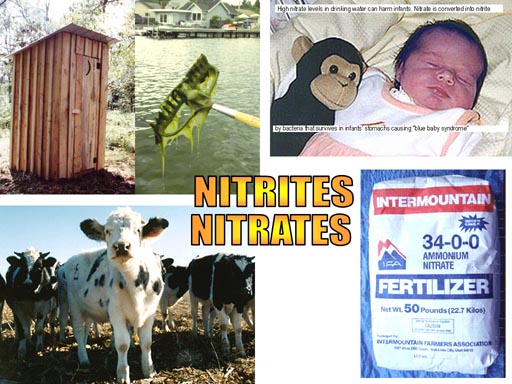
Nitrate (NO3-) & Nitrite (NO2-): These are produced by bacteria feeding off of human and animal waste. Nitrate can also come for fertilizers such as ammonium nitrate. High nitrate levels in drinking water can harm infants. Nitrate is converted into nitrite by bacteria that survives in infants’ stomachs. The nitrite ion enters the blood and converts the hemoglobin in red blood cells to methemoglobin The "met" is from "meta" meaning "changed." This "changed" hemoglobin has less ability to carry oxygen, causing a condition known as methemoglobinemia, also called "blue baby syndrome."
Tip on finding formula and name: Atoms that have a charge have a one-track mind. They are attracted to anything with the opposite charge. In the table below the positive metal ions on the left column will all be attracted to the negative non-metal ions on the top row. If the positive metal ion is 1+ and the negative ion is 1-, after they combine, their charges balance out to zero. Being zero charge, they will not attract any other atoms. So the final formula is set as one each. For example, Na+ + Cl- --> NaCl. Also, Ag+ + Cl- --> AgCl. If the metal ion is 2+ and the non-metal ion is 2-, they will also cancel their charges when they combine. So the final formula is one each. For example, Fe2+ + O2- --> FeO. Now lets look at Na+ being attracted to O2-. After they combine, there's still a negative one charge because (+1) + (-2) = (-1). So NaO still has a negative one charge (NaO-). That means they will attract another positive sodium ion (Na+). So, NaO- + Na+ --> Na2O. At this point the charges all cancel and Na2O is neutral so there's no more attraction, meaning that's the final formula. Remember, atoms can't think, but they can still make the right formula by simply coming together as long as there's a charge present.
Tip on finding name: When there are just two kinds of atoms, the name of the compound begins with the name of the positive ion (usually a metal). The second word is the name of the negative element except the name is shortened and "ide" is added.
Cl- |
O2- |
N3- |
S2- |
P3- |
|
Na+ |
NaCl Sodium chloride |
Na2O Sodium oxide |
Na3N Sodium nitride |
Na2S Sodium sulfide |
Na3P Sodium phosphide |
Mg2+ |
MgCl2 Magnesium chloride |
MgO Magnesium oxide |
Mg3N2 Magnesium nitride |
MgS Magnesium sulfide |
Mg3P2 Magnesium phosphide |
Al3+ |
AlCl3 Aluminum chloride |
Al3O2 Aluminum oxide |
AlN Aluminum nitride |
Al2S3 Aluminum sulfide |
AlP Aluminum phosphide |
Fe2+ |
FeCl2 Iron (II) chloride |
FeO Iron (II) oxide |
Fe3N2 Iron (II) nitride |
FeS Iron (II) sulfide |
Fe3P2 Iron (II) phosphide |
Ag+ |
AgCl Silver chloride |
Ag2O Silver oxide |
Ag3N Silver nitride |
Ag2S Silver sulfide |
Ag3P Silver phosphide |
Cu+ |
CuCl Copper (I) chloride |
Cu2O Copper (I) oxide |
Cu3N Copper (I) nitride |
Cu2S Copper (I) sulfide |
Cu3P Copper (I) phosphide |
Name |
Formula (Note: I added an equation to show how the ions combined) |
| Potassium sulfide | K2S (K+ + K+ + S2- --> K2S) |
| Silver bromide | AgBr (Ag+ + Br- --> AgBr) |
| Dinitrogen tetroxide | N2O4 |
| Nickel (II) sulfide | NiS (Ni2+ + S2- --> NiS) |
| Magnesium phosphide | Mg3P (Mg2+ + Mg2+ + Mg2+ + P3- + P3- --> Mg3P2) |
| Calcium oxide | CaO (Ca2+ + O2- --> CaO) |
| Chlorine trifluoride | ClF3 |
| Normally chlorine is seen at the end (Like NaCl). The more positive atom is written first. When non-metals combine with metlas, the metals have the positive charge and is written first. In this case chlorine is more positive than fluorine, so chlorine is written first. | |
| Lithium nitride | Li3N |
| Copper (I) phosphide | Cu3P |
| Since the phosphorus ion is a 3- charge and we see 3 copper atoms, that means the the copper must have a plus one charge. 3x(1+) balances with 3-. | |
| Aluminum chloride | AlCl3 |
| Sodium hydride | NaH |
| Iron (III) iodide | FeI3 |
CN- |
NO3- |
CO32- |
SO42- |
PO43- |
|
NH4+ |
NH4CN Ammonium cyanide |
NH4NO3 Ammonium nitrate |
(NH4)2CO3 Ammonium carbonate |
(NH4)2SO4 Ammonium sulfate |
(NH4)3PO4 Ammonium phosphate |
Ca2+ |
Mg(CN)2 Magnesium cyanide |
Mg(NO3)2 Magnesium nitrate |
MgCO3 Magnesium carbonate |
MgSO4 Magnesium sulfate |
Mg3(PO4)2 Magnesium phosphate |
Al3+ |
Al(CN)3 Aluminum cyanide |
Al(NO3)3 Aluminum nitrate |
Al2(CO3)3 Aluminum carbonate |
Al2(SO4)3 Aluminum sulfate |
AlPO4 Aluminum phosphate |
Cu2+ |
Cu(CN)2 Copper (II) cyanide |
Cu(NO3)2 Copper (II) nitrate |
CuCO3 Copper (II) carbonate |
CuSO4 Copper (II) sulfate |
Cu3(PO4)2 Copper (II) phosphate |
| Notice that iron (III) below has the same charge as aluminum above so the number of the anions (negative ions) will be the same. Since iron has more than one oxidation number, we must indicate which one it is. When aluminum combines, it only has a +3 charge, so there's no reason to indicate the charge. | |||||
Fe3+ |
Fe(CN)3 Iron (III) cyanide |
Fe(NO3)3 Iron (III) nitrate |
Fe2(CO3)3 Iron (III) carbonate |
Fe2(SO4)3 Iron (III) sulfate |
FePO4 Iron (III) phosphate |
| To find names, you can learn the rules. Also, if you have Internet access, try typing the formula in the search field (like in Google). For example, to find the name of H2CO3 type H2CO3 in the search field. You will likely see websites that show the name of carbonic acid. | |||||
H+ |
HCN hydrogen cyanide if gas hydrocyanic acid if in water |
HNO3 Nitric acid |
H2CO3 Carbonic acid |
H2SO4 Sulfuric acid |
H3PO4 Phosphoric acid |
Name |
Formula (I added an equation to show how the ions combined) |
| Potassium sulfate | K2SO4 (K+ + K+ + SO42- --> K2SO4) |
| Ammonium bromite | NH4BrO2 (NH4+ + BrO2- --> NH4BrO2) |
| Zinc nitrate | Zn(NO3)2 [Zn2+ + NO3- + NO3- --> Zn(NO3)2 ] |
| Sodium sulfite | NiS (Ni2+ + S2- --> NiS) |
| Iron (II) carbonate | FeCO3 (Fe2+ + CO32- --> FeCO3) |
| Magnesium hydrogen phosphate | MgHPO4 (Mg2+ + HPO42- --> MgHPO4) Note: Phosphate (PO43-) has negative 3 charge, but when combined with H+, one of the negative charges is canceled. So the result is a negative 2 charge. Since Magnesium ion is plus 2, the charges combine to be zero with one each. |
| Calcium chlorate | CaCl2 (Ca2+ + Cl- + Cl- --> CaCl2) |
| Cobalt (III) acetate | Co(C2H3O2)2 [ Co2+ + C2H3O2- + C2H3O2- --> Co(C2H3O2)2 ] |
| Sodium chromate | NaCrO4 ( Na+ + CrO4- --> NaCrO4) |
| Potassium dichromate | K2Cr2O7 |
| Aluminum nitrate | Al(NO3)3 |
| Mercury (II) cyanide | Hg(CN)2 |
| Manganese hydroxide | Mn(OH)2 |
| Lithium hypochlorite | LiClO |
| Sodium hydrogen carbonate (sodium bicarbonate) |
NaHCO3 |
You've been learning about the polyatomic ions that are usually combined with a metal. You will also see these polyatomic ions attached to various drugs. Most CHM130 and CHM151 classes that cover nomenclature never discuss how the polyatomic ions names are used with many of the drugs we see.
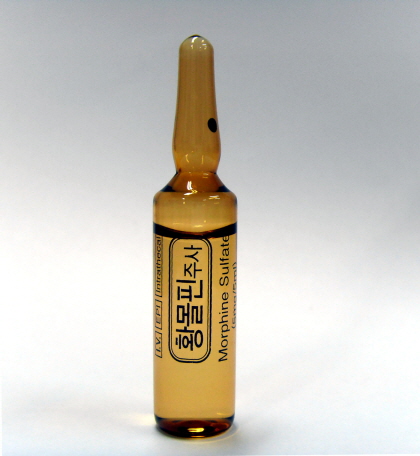
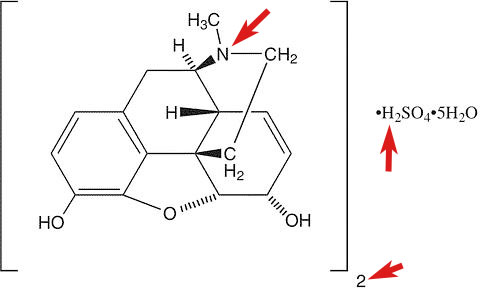
Morphine citrate (citric acid)
Morphine nitrate (nitric acid)
Morphine phosphate (phosphoric acid)
Morphine hydrochloride (hydrochloric acid)
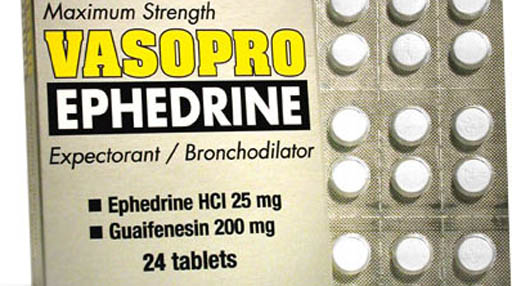
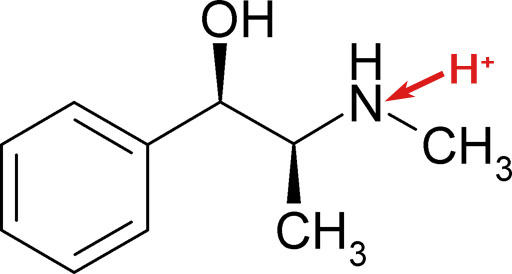
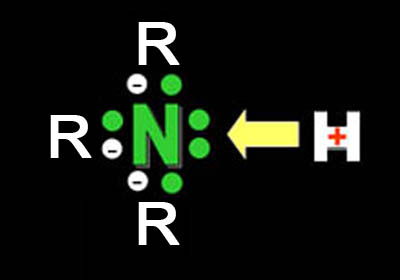
To the left is the structure of ephedrine. Notice the nitrogen. So this is another alkaloid compound. The nitrogen accepts the H+ ion coming from hydrochloric acid. The chloride ion remains nearby. This make ephedrine much more water soluble.
Nitrogen attracts hydrogen ions because there's a pair of extra electrons (unpaired electrons) where the H+ will be attracted. The "R's" represent some other element or group attached to the nitrogen. In other words, nitrogen can accept 3 electrons, so can bond with 3 other elements. But it also has those pair of electrons that do not bond with other elements does attract H+ ions.